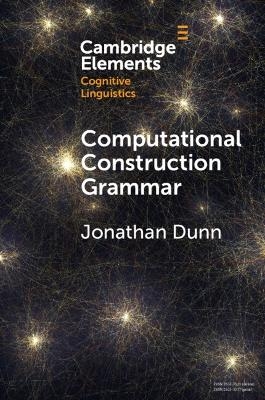
Computational Construction Grammar
A Usage-Based Approach
Seiten
2024
Cambridge University Press (Verlag)
978-1-009-23376-7 (ISBN)
Cambridge University Press (Verlag)
978-1-009-23376-7 (ISBN)
This Element introduces a usage-based computational approach to Construction Grammar that draws on techniques from natural language processing and unsupervised machine learning. The computational experiments are important for testing the learnability, variability, and confirmability of Construction Grammar as a theory of language.
This Element introduces a usage-based computational approach to Construction Grammar that draws on techniques from natural language processing and unsupervised machine learning. This work explores how to represent constructions, how to learn constructions from a corpus, and how to arrange the constructions in a grammar as a network. From a theoretical perspective, this Element examines how construction grammars emerge from usage alone as complex systems, with slot-constraints learned at the same time that constructions are learned. From a practical perspective, this work is accompanied by a Python package which enables linguists to incorporate construction grammars into their own corpus-based work. The computational experiments in this Element are important for testing the learnability, variability, and confirmability of Construction Grammar as a theory of language. All code examples will leverage the cloud computing platform Code Ocean to guide readers through implementation of these algorithms.
This Element introduces a usage-based computational approach to Construction Grammar that draws on techniques from natural language processing and unsupervised machine learning. This work explores how to represent constructions, how to learn constructions from a corpus, and how to arrange the constructions in a grammar as a network. From a theoretical perspective, this Element examines how construction grammars emerge from usage alone as complex systems, with slot-constraints learned at the same time that constructions are learned. From a practical perspective, this work is accompanied by a Python package which enables linguists to incorporate construction grammars into their own corpus-based work. The computational experiments in this Element are important for testing the learnability, variability, and confirmability of Construction Grammar as a theory of language. All code examples will leverage the cloud computing platform Code Ocean to guide readers through implementation of these algorithms.
1. Representing constructions; 2. Learning constructions; 3. Forming the constructicon; 4. Conclusions; References.
| Erscheinungsdatum | 25.05.2024 |
|---|---|
| Reihe/Serie | Elements in Cognitive Linguistics |
| Zusatzinfo | Worked examples or Exercises |
| Verlagsort | Cambridge |
| Sprache | englisch |
| Maße | 152 x 229 mm |
| Gewicht | 172 g |
| Themenwelt | Geisteswissenschaften ► Sprach- / Literaturwissenschaft ► Sprachwissenschaft |
| ISBN-10 | 1-009-23376-9 / 1009233769 |
| ISBN-13 | 978-1-009-23376-7 / 9781009233767 |
| Zustand | Neuware |
| Informationen gemäß Produktsicherheitsverordnung (GPSR) | |
| Haben Sie eine Frage zum Produkt? |
Mehr entdecken
aus dem Bereich
aus dem Bereich
Das umfassende Standardwerk auf der Grundlage der aktuellen amtlichen …
Buch | Hardcover (2024)
Duden (Cornelsen Verlag)
CHF 48,95


